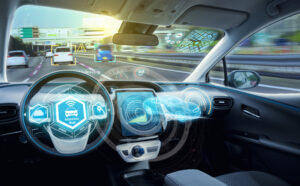
AAA finds ADAS increase repair costs by up to 37%
By onAnnouncements | Collision Repair | Market Trends | Technology
Advanced driver assistance systems (ADAS) – including automatic emergency braking (AEB), blind spot monitoring and lane departure warning – can increase repair costs by up to 37.6% after a crash, according to a recent study by AAA.
“Even minor damage to systems such as front radar or distance sensors can result in additional repair expenses up to $1,540,” a AAA press release states.
The increase comes from the cost of replacing and calibrating sensors, it said.
The AAA study follows a U.S. Department of Transportation’s National Highway Traffic Safety Administration (NHTSA) proposed rule requiring AEB and pedestrian AEB systems on passenger cars and light trucks.
“The proposed rule is expected to dramatically reduce crashes associated with pedestrians and rear-end crashes,” a NHTSA release said. “NHTSA projects that this proposed rule, if finalized, would save at least 360 lives a year and reduce injuries by at least 24,000 annually.”
Insurance Institute for Highway Safety (IIHS) and NHTSA worked together in 2016 to broker commitment by 20 manufacturers to equip passenger cars and light-duty trucks with AEB.
NHTSA’s proposal would ensure the systems work at higher speeds and stop for pedestrians, IIHS previously said.
AAA says the failure to complete costly repairs to damaged ADAS sensors could be deadly.
“Consumers should know about the repair costs associated with these technologies,” AAA said. “But they must also understand the importance of fixing them since improperly functioning systems could result in a deadly crash.”
Yet, many drivers recently surveyed by IIHS said they’ve had issues with the technology after repairs. It is not quantified to what degree insurance claims may factor into the quality of repair, but diagnostic companies have indicated that claims cost mitigation efforts, insurer pushback and failure to prioritize adherence to OEM procedures can be a contributing factor.
The AAA study said many collisions can cause some suspension damage, meaning a wheel alignment will be necessary.
“For ADAS-equipped vehicles, these systems need to know what direction the vehicle is traveling down the road to accurately make safety corrections and predictions,” the study said. “Vehicles equipped with ADAS, especially lane keeping assistance and automatic emergency braking, need to be properly aligned with how the vehicle is traveling down the road.”
Repairs, including wheel alignment, windshield and side mirror replacement, could need costly calibrations to ensure the ADAS works properly.
“Calibration cannot be ignored,” the study says. “Sensors that are out of alignment generate faulty information that will cause ADAS to operate improperly or not at all—creating a safety hazard.”
The AAA release indicated that drivers are alerted by a warning light or icon on the instrument panel or message display if an ADAS component is failing. This may set a false expectation for the motoring public, as many manufacturers have indicated that reality is that diagnostic trouble codes (DTCs) may not always display in a visible fashion on the dash, without performing necessary diagnostic tasks.
A November 2020 statement from American Honda on POST-COLLISION DIAGNOSTIC SCAN AND CALIBRATION REQUIREMENTS FOR HONDA AND ACURA VEHICLES indicates “the presence or absence of dashboard indicators/warning lights is not an acceptable method to determine if post collision diagnostic scans are necessary. Many DTCs do not illuminate any dashboard indicators, but an electronic control system may still operate improperly or be completely inoperative.”
A visual indicator won’t always be present, but there are instances where the driver may be alerted.
AAA’s study compared repair costs of four common repair scenarios – minor front collision repair, side mirror replacement, minor rear collision repair and windshield replacement. The study used the 2023 Ford F-150, Nissan Rouge and Toyota Camry models for the scenarios.
The average costs for ADAS Components in each repair:
-
- $1,540 or 13.2% of the total repair estimate of $11,708 for minor front collision repair
- $1,067 or 70.8% of the total repair estimate of $1,507 for side mirror replacement
- $684 or 40.9% of the total repair estimate of $1,698 for minor rear collision repair.
- $360.00 or 25.4% of the total repair estimate of $1,439.78 for windshield replacement and calibration.
Individual ADAS component costs ranged from $290 to $1,596, including parts and labor. AAA used a body rate of $75 an hour and a mechanical rate of $110 an hour was used for the study.
Collision repair estimates were prepared for the four hypothetical damage scenarios by professional auto insurance estimators in two locations: Southern California and Michigan, the report said. Both sources used CCC One estimating software.
The study reviewed the use of radar, ultrasonic and camera sensors used in adaptive cruise control, collision warning, AEB, lane departure warning, lane keeping assist, 360° surround view, park assist, automatic high beam, automatic headlamp leveling, adaptive front lighting and traffic sign recognition.
The Ford F-150 had the highest total repair cost for front impact at $14,645, compared to the Nissan Rogue, which cost $10,209. The F-150 also had the highest cost for side mirror damage at $1,910 compared to the Camry at $1,028.
On Rear Impact, the Nissan Rogue had the highest repair cost at $1,782, compared to the F-150, which had the lowest cost at $1,578. The Rogue also had the highest repair cost for a windshield replacement at $1,687 and the F-150 cost the lowest amount of $1,259.
Images
Photo courtesy of metamorworks/iStock
